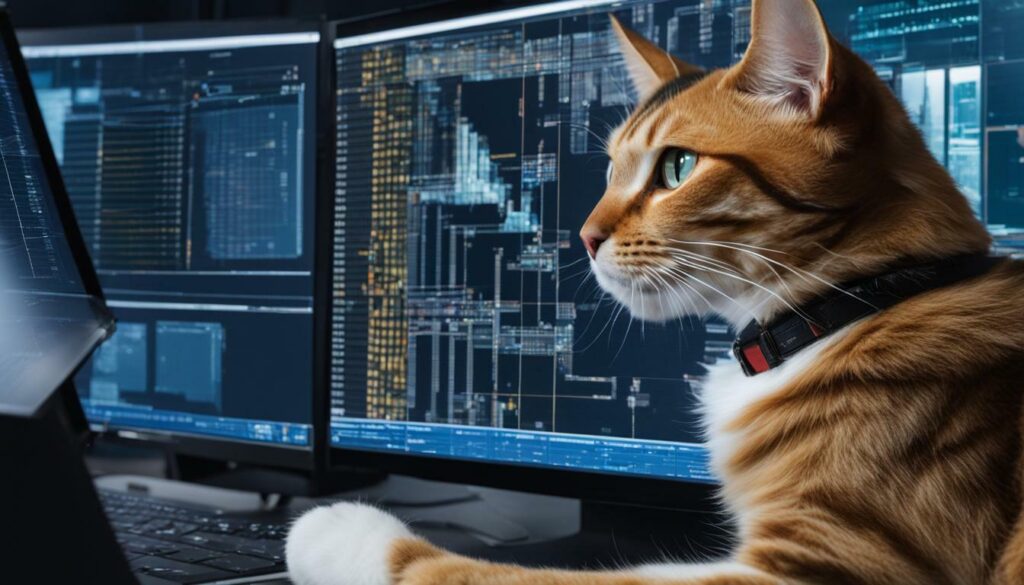Table of Contents
Managing the growing population of stray cats can be a challenging and complex task for animal control organizations and shelters. With the advancement of technology, artificial intelligence (AI) has emerged as a promising solution to improve the treatment and control of stray cats. AI technology can assist in identifying, tracking, and monitoring the movements of stray cats. It can also help provide healthcare, medical treatment, and population control programs for these animals.
Key Takeaways:
- Artificial intelligence is being utilized in stray cat management to improve humane treatment and control.
- AI technology can aid in the identification, tracking, and monitoring of stray cats.
- AI can also assist in providing healthcare, medical treatment, and population control programs for stray cats.
Understanding Stray Cat Management Challenges
Stray cat management is not an easy task, and it comes with several challenges. The primary challenge is the sheer number of stray cats, which is often difficult to estimate accurately. Most rescue and management efforts rely on manual counting and tracking, which is both time-consuming and imprecise.
Another key challenge is the lack of a centralized database for tracking and identifying stray cats. Many rescue organizations operate independently, making it difficult to coordinate efforts and track the progress of interventions. As a result, it can be challenging to determine the effectiveness of different interventions, which hinders future decision-making.
Effective stray cat management requires a systematic and coordinated approach. With the integration of AI-based solutions, managing the challenges can become much more efficient. AI technology can be used to analyze and classify cat images, track their movements, and even manage the population through sterilization programs.
By leveraging AI, more precise and automated systems can be developed, leading to a more efficient and effective approach to stray cat management. The potential benefits of integrating AI solutions include better and more humane treatment of stray cats, reduced healthcare costs, and a significant reduction in the stray cat population.
The Role of Artificial Intelligence in Stray Cat Identification
Artificial intelligence (AI) technology is revolutionizing the way people manage stray cats. AI solutions for stray cat management are becoming increasingly sophisticated, making it easier to identify, track, and monitor the movements of stray cats. This section will focus on the role of AI technology in stray cat identification, exploring the various AI algorithms and techniques used to analyze and classify cat images, enabling more efficient identification and tracking.
One of the challenges in stray cat management is identifying individual cats. In the past, this was typically done through visual recognition by volunteers or animal control officers. However, this method is time-consuming and unreliable, particularly when dealing with large populations of cats.
With the advent of AI technology, identifying stray cats has become more efficient and accurate. Machine learning algorithms can analyze digital images of cats and classify them based on various characteristics, such as fur color, pattern, and body shape. This allows for faster and more accurate identification of individual cats, enabling better tracking and monitoring.
Facial recognition technology is also being used in stray cat identification. By analyzing unique features of a cat’s face, such as the shape of the eyes, nose, and mouth, AI algorithms can identify individual cats with a high degree of accuracy. This technology can also be used to identify cats in low-light or blurry images, making it an effective tool for stray cat management.
Overall, AI technology is proving to be a valuable tool in the humane and effective management of stray cats. By improving identification and tracking, AI solutions for stray cat management can help reduce the number of cats living on the streets, while also improving their overall health and well-being.
AI-Driven Tracking and Monitoring Systems for Stray Cat Management
Implementing AI in stray cat management has paved the way for advanced tracking and monitoring systems. These systems enable organizations to manage and control the movement of stray cats more effectively. With AI solutions, tracking, and monitoring the activities of stray cats has become more accessible than ever.
GPS tracking technology is widely used in monitoring the movement of stray cats. With this technology, organizations can track the location of cats and map their movements. Facial recognition technology is also used to identify specific cats and track their behavior. By analyzing and comparing facial features of different cats, the technology can recognize and differentiate between individual cats.
Moreover, machine learning algorithms are used to analyze and interpret the data recorded by tracking and monitoring systems. This helps organizations to gain insights into the behavior and activities of stray cats. They can leverage this information to improve their management strategies and provide better care to the cats. These AI-powered systems play a crucial role in ensuring the safety and well-being of stray cats.
Overall, implementing AI technology in stray cat management has revolutionized the way we handle and control the movement of stray cats. With advanced tracking and monitoring systems, organizations can more effectively manage the stray cat population and provide better care for these vulnerable animals. The use of AI technology in stray cat management has not only improved the efficiency of the process but also ensures the humane treatment of these animals.
The Role of Artificial Intelligence in Stray Cat Healthcare and Medical Treatment
One of the major benefits of AI in stray cat management is its ability to assist in healthcare and medical treatment. Many stray cats suffer from common health issues that require immediate medical attention. Unfortunately, due to the overwhelming number of stray cats and the lack of resources, it is often impossible to provide timely care to every cat in need.
AI-powered medical diagnosis and treatment systems can help bridge this gap. With machine learning algorithms, these systems can quickly analyze and diagnose various health conditions, ensuring that the cats receive the necessary treatment promptly. Additionally, automated monitoring systems can help track the health of stray cats, alerting caretakers when intervention is required.
By utilizing AI technology in healthcare and medical treatment, stray cats can receive timely and effective care, improving their overall well-being and quality of life. Furthermore, this technology can aid in reducing the spread of diseases and illnesses among the stray cat population, mitigating potential public health risks.
Overall, the benefits of AI in stray cat healthcare and medical treatment are tremendous, offering a viable solution to addressing the health needs of a large and diverse population of stray cats.
The Role of Artificial Intelligence in Stray Cat Identification
Identifying stray cats is a fundamental element of stray cat management. However, it can be a challenging and time-consuming task, especially in areas with a high population of feral cats. This is where artificial intelligence (AI) technology can come in handy. AI algorithms and models can effectively recognize and classify cat images, streamlining identification and tracking processes.
AI-powered image recognition software can analyze various features of cat images, such as fur color, eye color, and patterns, and accurately identify the cat breed. The technology can also differentiate between adult cats and kittens, providing valuable insight into the cat population dynamics.
AI can also assist in identifying and distinguishing between stray cats and owned cats. Facial recognition technology can recognize cats that have been previously tagged, enabling faster identification in case of displacement. With AI, it is easier to track and monitor the movements of these cats in real-time, which can help in developing effective management strategies.
Given the significant progress in AI technology, the role of AI in stray cat identification is set to become even more critical in the future. With better algorithms and higher accuracy rates, AI-powered solutions can be a vital tool in managing and controlling stray cats.
Community Engagement and Adoption Programs Supported by AI
Artificial intelligence (AI) technology is not only revolutionizing stray cat identification, tracking, and medical treatment, but it is also being used to improve community engagement and adoption programs for stray cats. With the help of AI-powered platforms and applications, volunteers, organizations, and potential adopters can connect more easily and effectively, promoting responsible cat ownership.
By leveraging AI, organizations can create online portals and social media groups where volunteers can coordinate with each other and keep track of the status and well-being of the cats they are caring for. Adopters can also use these platforms to search for cats that match their preferences and lifestyle, increasing the chances of finding suitable homes for the cats.
Furthermore, AI-powered chatbots and virtual assistants can provide 24/7 support to individuals seeking information about adopting, fostering, or caring for stray cats. These chatbots can answer frequently asked questions, provide helpful resources, and connect individuals with local organizations and volunteers.
Overall, AI-assisted community engagement and adoption programs can help increase awareness of the importance of responsible cat ownership, decrease the number of cats running loose on the streets, and promote the overall well-being of stray cats in the community.
Conclusion
In conclusion, the use of AI technology in stray cat management has significant potential to improve the quality of life for stray cats and the communities that interact with them. By leveraging AI-powered solutions, animal welfare organizations can better address the challenges of managing stray cat populations, from identifying and tracking cats to providing them with medical care and facilitating adoptions.
Effective stray cat management is crucial for ensuring the well-being of both the cats and the surrounding community. The integration of AI in stray cat management provides numerous benefits, including more efficient management processes, increased accuracy in identifying cats, and reduced strain on limited resources.
Incorporating AI-driven approaches to stray cat management represents a promising step forward for animal welfare and the humane treatment of stray cats. Implementing these technologies can ensure that stray cats are cared for appropriately, reducing their impact on the environment and improving the quality of life for both cats and humans.
Overall, the use of AI in stray cat management is a crucial step towards addressing the long-standing challenges posed by stray cat populations. By leveraging technology to better manage these populations, animal welfare organizations can significantly improve the outcomes for stray cats and the communities that interact with them. With continued innovation and development, AI-powered solutions will continue to play an increasingly important role in the future of stray cat management.



